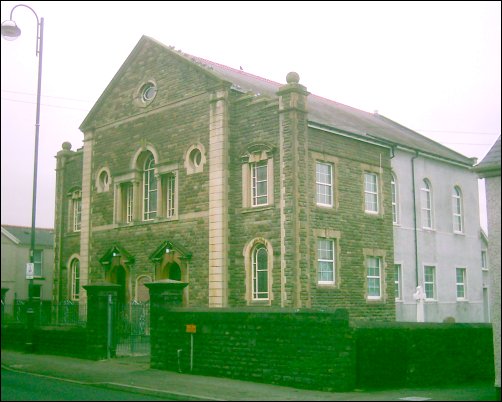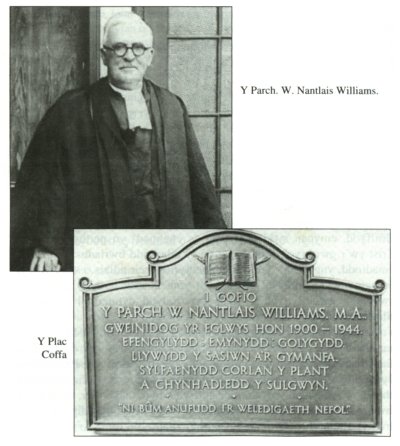Bethany Calvinist Methodist Church was the last of the major chapels in Ammanford to be built, and until this the town's Methodist worshippers were catered for by a chapel in Betws. In 1885, the places of worship in the region of Betws and Ammanford were:
– St David's Church, Betws Road, (the established church, 13th century in origin with major 19th century alterations. – Christian Temple (Independent/Congregationalist or Capel yr Annibynwyr) on High Street. Founded in 1748, rebuilt 1782, 1836, 1865. – Seion Chapel, Betws Road (Welsh Calvinistic Methodist) Built 1795, rebuilt 1829 and 1898. – English Wesleyan Methodist, on Wind Street. Founded in 1875, closed 1957. – Ebenezer Chapel (Welsh Baptist) on Baptist Lane. Founded in 1850, rebuilt and enlarged 1877. – St Michael's Church (Anglican). Built 1885. – Bethany Methodist Chapel, built 1880, rebuilt 1929. Throughout Ammanford's early history, the huge influx of people seeking employment and opportunity in the rapidly expanding industries meant more church and chapel building to accommodate the new worshippers. The Welsh Methodist chapel of Seion had been built in Betws as early as 1795 and rebuilt in 1829. In 1898, a new Welsh Methodist chapel was built at a different site on Betws Road, this time renamed "Capel Newydd" (New Chapel). Capel Seion was abandoned and eventually demolished in 1939 to make way for road widening, although its cemetery is still used for burials.
Ammanford by now was ready for a Methodist chapel of its own, though not without the usual opposition that seemed to accompany the establishment of every new religious house. The worry presumably was that any new church would entice exisiting worshippers away. Strange how those who experience opposition to their own efforts are the first to oppose others who come along later.
So in 1875 several worthies met at the residence of John Morris in Field Street (renamed Heol Wallasey in 1957) to start the wheels in motion for the founding of a new Methodist Church in Cross Inn.
A committee of 33 of the town's great and good next acquired a plot of land in Wind Street from Lord Dynevor, and in 1880 the foundation stone for what would become Bethany was laid. The name (beth-a-ny), is Biblical in origin, meaning 'house of dates' and was a village near Jerusalem from where Christ ascended to heaven:
And he led them out as far as to Bethany, and he lifted up his hands, and blessed them. And it came to pass, while he blessed them, he was parted from them, and carried up into heaven. (Luke 24: 50,51)
That same year, coincidently, Cross Inn changed its name to Ammanford. The new chapel at a cost of £900 held its first service in 1881 and membership rapidly grew especially under the guidance of the Reverend W. Nantlais Williams, famous poet and hymn writer, who was their minister from 1900 to 1944. Once again a chapel built in Ammanford proved too small for a growing town population and a decision to rebuild was taken in 1927. The new Bethany was re-opened in 1929 with its seating capacity now having grown to 800, with room for another 300 in the adjoining vestry.
The building, constructed by local contractor William Evans, is impressive in the somewhat brutal style of the period, with its facade of Pennant, Forest of Dean and Bath stone. The building costs of £11,000 in 1929 must have impressed Ammanford folk as much as the building itself.
A defining image of Welsh towns and villages - the Chapel. Here, Ammanford's Bethany, first opened for worship in 1881 and extensively re-built in 1929, seems to be telling us who is in charge. NANTLAIS
Finally, here is a brief biography of Bethany's longest serving minister, 'Nantlais', the Reverend William Nantlais Williams (1874 - 1959)The Reverend William Nantlais Williams was the best known and longest serving minister of Bethany Chapel. Born in Pencader, Carmarthenshire in 1874, he became the minister of Bethany, a Calvinistic Methodist chapel, in 1900, not long after its founding in 1881, and stayed a minister there for 44 years. He retired as minister in 1944, living out his life in Ammanford until his death in 1959 at the age of 85.
He was known as a stern leader, keeping a disciplined watch over his flock. He was much travelled, visiting Patagonia, a Welsh speaking region of Argentina, in the 1930s. Like his fellow minister-poets Llwyd and Watcyn Wyn he was a highly accomplished poet and hymn writer.
Those who remember their Sunday school days will also remember having sung one of his hymns, "Iesu cofio'r plant", better known by its first line "Draw draw yn China". Other well known hymns from his pen were, "Plant bach Iesu Crist ydym ni bob un (Little children of Christ are we, every one) and "Uno wnawn a'r nefol gor" (There a noon and a heavenly choir).
(A more detailed history of Nantlais can be found in the 'People' section of this website, or click HERE.)
When Amman Valley Grammar School became a comprehensive in 1970, one of the school houses was called 'Nantlais' in his memory.
(The other houses in the new comprehensive school were also named after local poets, namely Watcyn, Amanwy and Llwyd. The houses in the former Grammar School had been named after the Welsh princes - and warriors - Hywel, Glyndwr, Llewelyn and Dewi. An improvement in whom we should regard as role models, perhaps).
Nantlais and his memorial plaque on Bethany wallDate this page last updated: August 31, 2010


